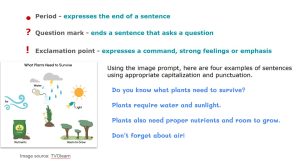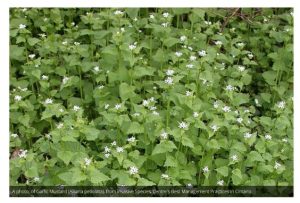16 Sentences – Capitalization and Punctuation
Category: Sentences
Concept: Capitalization and Punctuation
Connections to The Ontario Curriculum, Grades 1-8: Language (2023):
—–B3. Language Conventions for Reading and Writing
———-B3.3 Capitalization and Punctuation
Prior Knowledge:
- Understanding that a sentence expresses a complete thought, starts with a capital letter, and ends with the appropriate punctuation
- Understanding that different sentences types use different types of punctuation
- Recognizing that proper punctuation use can help writers avoid sentence fragments and run-on sentences
What’s the definition?
Capitalization: The use of a capital letter to begin a sentence.
Punctuation: The use of symbols (e.g., periods, commas, semicolons) to distinguish elements within a sentence or to separate sentences. Punctuation marks create and clarify meaning in a written text and help the reader understand.
The Ontario Curriculum, Grades 1-8: Language (2023)
What does it look/sound like?


Why does it matter?
The Ontario Language Curriculum indicates that, by grade 4, students should be refining their understanding of starting a sentence with a capital letter and ending a variety of sentence types with appropriate punctuation.
The Ontario Curriculum, Grades 1-8: Language (2023) – Appendix B: Language Conventions Continuum for Reading and Writing, Grades 1–9, Overall Expectation B3
Refining these fundamental concepts assists students in expressing their ideas, especially in written text:
- When students understand the functions of punctuation, they can begin to determine how to express their ideas for intended meaning.
- As students work through their understanding, they can improve their ability to self-edit their compositions.
How do I teach this?
A tiered approach can be considered when teaching punctuation and capitalization in the context of sentences. Consider, to start, showing the punctuation used in the four sentence types. An anchor chart or other reference can be a useful guide and reminder (see Sentence Types).
Use image prompts in multiple subject areas and have students craft a variety of sentences using capitalization to begin their sentences, and appropriate punctuation to complete their sentences. See sample above.
Once students demonstrate an understanding of these basic punctuation uses, consider extending to semi-colons, colons, dashes, brackets and ellipses. This helps students explore the ways in which they can express their ideas in sentences for their intended audience and purpose.
You can use image prompts to help.

Image source: Ausable Bayfield Conservation https://www.abca.ca/post/=1571
Using the image prompt, here are four sentences using appropriate capitalization and punctuation.
I didn’t know that garlic mustard was an invasive species; it’s common where I live so I presumed it’s in its natural habitat.
Apparently it crowds out native plants (that grow naturally in an ecosystem) and can result in a loss of plants like milkweed, crucial for an endangered species – the monarch butterfly.
According to Ausable Bayfield Conservation: “When an invasive plant like Garlic Mustard crowds out Milkweed in the area, it depletes crucial food sources for the caterpillars and therefore contributes to the decline of Monarch butterflies.”
I wonder… can we stop it from taking over?
Using image prompts can also provide an opportunity to teach foundational language skills in cross-curricular studies.
Consider teaching comma use on its own. It can be beneficial to wait until students understand “end” punctuation (to complete a thought in a sentence) before focusing on commas. A frequent error in sentence structure is the comma splice. Keeping the focus on “end” punctuation can help students consolidate their understanding of complete sentences first, before moving on to refining their use of commas.
Use students’ own writing, text creation, and reading for examples. This contextualizes student understanding with authentic texts.
When required, create smaller writing groups for additional support. Use multiple examples from their own texts (correct and incorrect), as well as generated examples for their use.
…………………
Online Resources:
This TVO video resource “Grammified” contains multiple videos to support learning for capitalization and punctuation.
This TVO Kids video, called Every Sentence Has to End (1:49), provides a useful overview suitable for introduction and/or review of punctuation in sentence types.
Link: https://www.tvokids.com/school-age/wacky-word-songs/videos/every-sentence-has-end
Another TVO Kids video is specifically about using parentheses:
Link: https://www.tvokids.com/school-age/wacky-word-songs/videos/alone-crowd
Here is a learning activity on editing and proofreading that is a useful supplement to learning about and applying understanding of capitalization and punctuation.
TVOlearn – Editing and Proofreading
https://tvolearn.com/pages/grade-5-language-writing-learning-activity-10
Comma use for pauses and lists (suitable for younger grades) (1:12 minutes)
Another video for extended use and understanding of the comma in sentences, with examples (5:06 minutes)
English has four main sentence types:
declarative. A sentence that makes a statement.
imperative. A sentence that makes a request or gives a command or instruction.
interrogative. A sentence that asks a question.
exclamatory. A sentence that expresses strong emotion or feelings and ends in an exclamation mark.
See also punctuation.
The use of symbols (e.g., periods, commas, semicolons) to distinguish elements within a sentence or to separate sentences. Punctuation marks create and clarify meaning in a written text and help the reader understand how text sounds when it is read aloud. See also parts of speech, sentence types.
A sentence fragment does not have both a subject and a predicate; as such it does not express a complete thought.
A run-on sentence contains multiple independent clauses but does not have punctuation to indicate where one thought is complete before starting the next one.

